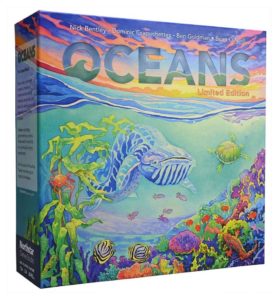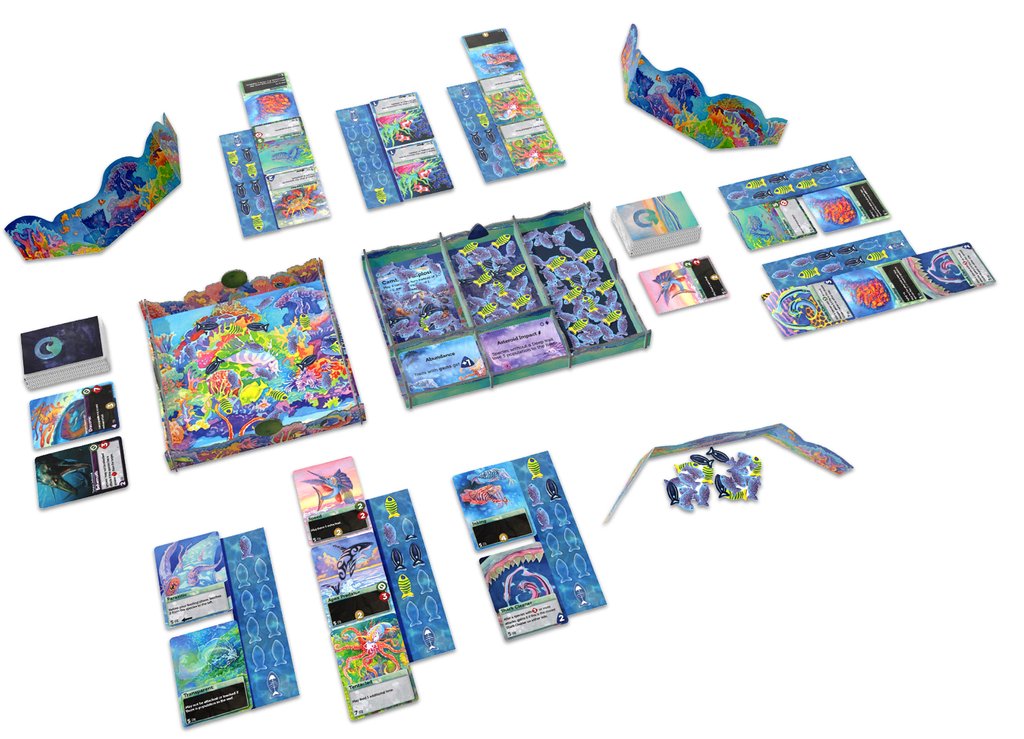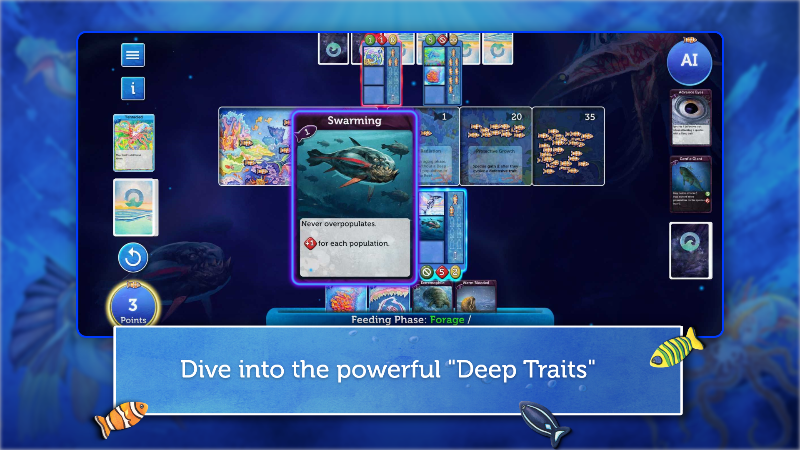Unplugged: Oceans (Boardgame)
 Players take on the role of ocean gatherers, hunters, and scavengers in this card game of species evolving and jostling for survival in the ocean blue. A spiritual successor to the Evolution line of games, Oceans takes the game in a slightly more strategic direction, as a slightly faster flow, and favors a slightly less aggressive style of play. Whereas Evolution provided food to players at a regular rate, Oceans leaves the management of available food in the players’ hands. A great compliment to Evolution, gamers who like the former should like the new game but will have to decide if they are different enough to keep both on the shelf. As a special bonus for reading this far, I’ll note that Oceans (Oceans Board Game Lite) is available as a free app you can play on your phone! Give it a download and see whether you need to run out and buy a copy of the game for Christmas.
Players take on the role of ocean gatherers, hunters, and scavengers in this card game of species evolving and jostling for survival in the ocean blue. A spiritual successor to the Evolution line of games, Oceans takes the game in a slightly more strategic direction, as a slightly faster flow, and favors a slightly less aggressive style of play. Whereas Evolution provided food to players at a regular rate, Oceans leaves the management of available food in the players’ hands. A great compliment to Evolution, gamers who like the former should like the new game but will have to decide if they are different enough to keep both on the shelf. As a special bonus for reading this far, I’ll note that Oceans (Oceans Board Game Lite) is available as a free app you can play on your phone! Give it a download and see whether you need to run out and buy a copy of the game for Christmas.
Oceans
Publisher: NorthStar Games
Ages: 12+
Players: 2-4
Time: 60-90 mins
(Review copy provided by North Star Games)
The game starts with each player dealt a hand of cards and a central board layout consisting of three feeding areas full of fish. Players then take turns playing cards from their hand, feeding their fish food, and then drawing new cards. The goal of the game is to eat the most food throughout the game.

Playing Cards
Players can use cards in two main ways. They can be simply played to the table creating a new species or adding traits to species already in play. Otherwise, a card can be discarded in order to move fish in and around in the three feeding areas, typically to replenish an area just before a player’s species needs to eat. At the start of the game players may play only one card, but in the latter stages players can play two. Players then discard any cards they don’t want and then refresh their hand by drawing back up to 6 cards. There are special “Deep” cards that can be drawn that have advanced abilities but they can only be used once the latter phase of the game kicks in.
Feeding
As food equals points in this game, the feeding phase is all about trying to get as much food as possible. However, no matter how many species a player controls, they still only get to feed with one species. The species either gets food from the central feeding area, or attacks another species on the table (even your own!) and steals food from them. Since only one species gets to feed and species that run out of food die off, it is important to find other ways for your species to eat. Feeding is so important that most of the trait cards in the game have to deal with how much food is eaten, whether a species can attack or be attacked, how much food can be stored up, and multiple different ways a species can “eat” even if not taking the feed action. (For example, one species might get free food if it is near another species that successfully attacked another…) Food is stored (up to a maximum) on the species card, until removed during the aging phase. Depending on how much food is left, emptying out a feeding area either triggers the mid-game switch or the end of the game itself. The mid-game switch is when gameplay moves to 2 cards & 2 food per turn and allows play of the Deep species cards (which also require a player to “pay” food from their hoard to play onto the table.) This also triggers a scenario effect that has a slight twist to the rules. Since this is known from the start of the game, good players can plan ahead to take advantage of this change. This also keeps the game fresh as there are many different possible scenario cards that can be chosen to use in a particular game.
Aging
Once feeding is done, aging happens. This is when food stored on a species board is moved off the board into a payer’s score pile. Initially, one food is removed from each species when they age, but after the Deep cards come out, two food are removed each round. Species who don’t have enough food to age correctly are eliminated from the board (with no further penalty.) It is ok to be completely out of food stored on a card, as long as there was enough food on the species for the feeding phase.
Drawing Cards
A player ends their turn by discarding any unwanted cards and then drawing cards up to a hand of 6. (A quick side note: I consider any game flawed if it has players start by drawing cards. There is rarely any good reason players shouldn’t have their cards in hand to plan during other player’s turns.) When drawing cards, players may draw from the more powerful and/or complex Deep card pile. A player draws three and picks one to keep. However, Deep cards cannot be played until the second half of the game, and they can never be discarded during the drawing card phase.
End Game
When all three feeding areas are empty of food, the game ends when everyone has had the same number of turns. Players score a point for each food eaten during the game, as well as any food still sitting on their species cards.
Verdict:
Oceans is one of those games where the basic rules are straightforward while the complexity comes in as a result of all the exceptions that come into play via the game components – the trait cards in this instance. This means the game is simple to teach and the main idea is easy to grasp. However, the many ways in which the species attributes can interact mean that it is difficult to play well in one’s first play through. It doesn’t have the simplicity of a game like Ticket to Ride or Carcassonne (or even Settlers of Catan) but the basic rules are still easy to grasp and the game flows along at a good pace.
The theme and the resulting art and color scheme makes for a nice visual experience, while not entirely necessary, it helps draw more casual gamers into the game. There are some player vs player interactions, but it is somewhat limited – each player can only feed or attack once per turn and even if multiple people try to prey on one particular player, the player will soon run out of food on which to feed. (Unlike the game Evolution, here species don’t die out until they’re out of food at the end of one’s turn so there’s always a chance of getting new food before that happens.) The theme also allows a bit of an educational experience. Each trait card provides an effect that thematically matches its use “in the wild.” In this way, players can see the advantages of specific traits and trait-combinations that exist in nature.
I am a big fan of the game Evolution. As Oceans is a sort of sequel, it is difficult for me to talk about one without the other. As with Evolution, players use their cards in several different ways (to replenish food, create a species or add traits) an elegant way to increase player choice without overcomplicating mechanisms. Evolution is all about players creating as many species as possible and then keeping them alive as long as possible while possibly trying to remove other players’ species at the same time. Due to the feeding limitation, Oceans has players focusing on fewer species and trying to make the ones they have more effective and self-sufficient. Player interaction is slightly less because direct player aggression is more limited. As a family gamer where feelings can sometimes get hurt (particularly the issue of ganging up on the leader) having a bit less aggression is a good thing. New players may find it hard to win their first game, but due to the way the game is structured, it doesn’t result devolve into the situation where piling on the losing player is the best strategy. Is Oceans better than Evolution? Perhaps surprisingly, it is a tough call for me to make. I love the theme of Evolution – making a “long-necked, burrowing species with extra fat tissue” is just plain silly and fun. You can do the same in Oceans but somehow I like the traits better in Evolution, especially as you tend to create far more species throughout a game of Evolution than in Oceans. On the other hand, I love the idea of the “Deep” cards with their more powerful and unique abilities balanced with the need to pay for them out of one’s own food stash (score pile.) The publisher shared an interesting idea for beginners, playing the game without the Deep cards. Since they are all different, it removes some of the complexity and long-term planning that accompanies use of the Deep cards.
Do you like Evolution and want more? Oceans is a no-brainer. If Evolution is good and you’re looking to extend the variety of your gaming collection, perhaps Oceans won’t bring enough new variety to the table. If you’re trying to decide between the two it will depend on your preferences. Evolution has more of a roller-coaster ride as species come and go while Oceans has more of a steady forward progression. Evolution is more combative of the two (although Oceans still has some.) With fewer species around, Oceans seems to have a better flow – particularly at higher player counts. Another point in favor of Oceans are the scenario cards (which activate partyway through the game) which gives each game a bit of different spin whereas Evolution relies just on the card variety to make each game unique. While the themes are similar, they are slightly different. Someone crazy about the sea will obviously favor Oceans while Evolution is perhaps the better pick if you are a huge dinosaur fan. In either case, they are a solid game that falls perfectly in the category of family-friendly strategy games.

Looking Forward:
As mentioned, a free version of Oceans (2 player only, fewer unique cards and scenarios, and only vs the basic AI, but does have a good tutorial) is out on Android and iOS so there’s no downside to giving it a try. Evolution is also available digitally on most platforms (including a recent release onto the Nintendo Switch.) Finally, there will be an Oceans expansion “Legends of the Deep” coming next year which adds in some fantastical creature options, taking it away from its core science roots but I expect it should produce some interesting gameplay.
Kid Factor:
OK, this game is more complex than some and since there are a large number of different cards, reading is almost a must (unless one is willing to play the game enough times….) While the box quotes a 12+ age group, I suspect that is more of a “don’t swallow the components” legality choice. I’d easily go down to 10+ or even more if the player is already a boardgaming fan. I also have to give the game props for its faithfulness to the core material. The variety and effects of the different traits cards make the game somewhat educational, despite its excellent gameplay. As mentioned, for a simpler game you can even play with out the Deep cards to lessen the rules-overhead for beginning gamers.





Discussion Area - Leave a Comment